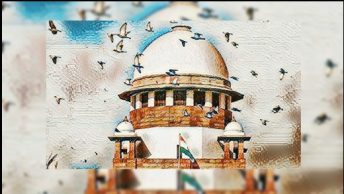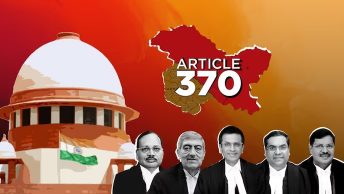Guest Post by Vivek Anandh, an advocate in the Delhi High Court
The recent decision of the Supreme Court to refer the Sabarimala Temple entry issue to a larger constitutional bench has thrown up a lot fascinating questions for the court to decide. In the communal rights jurisprudence that has so far been established by the Supreme Court in a series of cases such cases are put through examination on these three basis
- Whether a claim is a religious claim at all or not.
- If yes, whether it forms an ‘essential’ part of the religion or not.
- If it is found essential, whether it is in public interest or not.
Broadly in the questions formulated by the bench in the referral order are in conformity with these established tenets.
Question No.1: Exclusionary Practice & Discrimination
The basis upon which women between the age of 10 and 50 are denied entry into Sabarimala is upon a archaic and regressive conception that menstruating women are impure and that the presence of women could result in deviation from celibacy. The women in this method are essentially prevented merely because of their sex and physiological reason. In particular this practice prevents the menstruating women from entering the precincts (which presumably is the intention behind the expression ‘at any stage of time’ occurring in Rule 3(b)). Of the entire hindu population only menstruating women are prohibited here. Though it can be argued that women who are below the age of 10 and above the age of 50 are permitted it cannot be termed as a discrimination which is based only upon sex, as it does not discriminate all women. This cannot find any support within the discriminatory laws jurisprudence since only women can menstruate and therefore it is a discrimination which is based only on sex. Even otherwise
Moreover, it is a well established law that it is the impact of the law which must determine the and not otherwise. The essential result of this prohibition is the exclusion of a major section of women’s population from exercising their fundamental right to practise their religion. Given the recent articulate expansion of arbitrariness doctrine under Article 14 to strike down state actions by the Supreme Court in the recently delivered judgement on Triple Talaq the prohibition should also pass the bar under it. Arguably, as it has been explained in answer to question 5, the impugned rule 3 (b) itself is ultra vires the parent act, the prohibition cannot be said to be based on any valid law making it arbitrary and hence unconstitutional.
Question No.2: Essential Practices Test
This a highly controversial test developed by the Supreme Court to define the contours of protection offered for religious rights offered under the Constitution. First developed by the court in the Religious Endowments Case (AIR 1954 SC 282) this is a highly intrusive test which distinguishes those practices which form the ‘essential’ part of the religion and those that are extraneous to it. The distinction is to confer the constitutional privileges only to those practices which are found essential. As one would expect, the decision of what constitutes those ‘essential practices’ is decided by the court. This interventionist approach gets into the picture an externally dictated definition of what constitutes the religion rather than the how the follower of a particular religion views it to be. It replaces the internal belief system of an individual as against a institutionalised version of the same, fundamentally reversing the freedom of choice of an individual to view her religion as she deems it fit. This test cannot be sustained for various reasons, firstly the court cannot rely upon any precise doctrinal standards which it can formulate to test whether a practice is essential to the religion or not; secondly the court in order to arrive at a decision cannot but rely upon the selective display of religious texts that rival parties present before the court to support their case to decide. It cannot justify itself to be a complete inquiry into all the documents which matter for the inquiry; thirdly such religious documents and their meaning to the cause are matters of subjective interpretation with possible variance even amongst the believers of the same religious denomination; fourthly such cases counterintuitively deprives the freedom of a believer to practice the belief system the way he finds it to be fit; fifthly the test can be seen as wholly unnecessary when the such practices are tested upon the anvil of other all important civil liberties recognised under the constitution and by distinguishing the obvious secular aspects of the practices. In an apparent conflict between individual liberties with the communal rights it is the former which must prevail; sixthly by denying the non-essential aspects of the religion too could possibly stand in violation of the freedom to practice religion as guaranteed by the Constitution.
However, the Supreme Court has consistently applied this test and in fact recently it has taken upon itself to even decide whether keeping a beard is an essential part of one’s religion or not (Mohammed Zubair Corporal No.781467-G Vs. Union of India & Ors. Civil Appeal No. 8643 of 2009). Though a valuable opportunity presented itself to do away with this test in the recently delivered judgement declaring Triple Talaq as unconstitutional the court failed to consider it. Given the fact that the present referral order is to a five judge bench the court must consider discarding this test altogether. From the perspective of the referral order there does not arise a necessity to inquire whether the practice of excluding such women constitutes an “essential religious practice” under Article 25. The larger questions of equality and the stigma attached to the women, as analysed in answer to previous question, would shows us that such activities would fall under secular aspects which must be in conformity to other forms of individual liberties under Part III. With the changing conceptions of belief systems, when the then prevalent regressive religious practices such as Sati which had a long and established tradition were outlawed, why not a practice which excludes women based on their physiology on the grounds of ritual purity? The constitutional assembly debates on Article 25 too supports this view that the freedom of religion must not come in the way of any social reform, as specific exceptions made thereunder inform us. It must be noted that these references were made with the social reforms to salvage the social position of women in mind by the several members of the assembly.
Question No.3: A Religious Denomination
The Respondents in this case seeks to argue out the questions raised by this practise by claiming the followers of Sabarimala Temple as a separate religious denomination, to bring the practise under the purview of protection offered by Article 26 of the Constitution. This argument does not fund any support from the broad version of ‘Hinduism’ as has been so far defined by the Supreme Court. It is difficult to separate the followers of Sabarimala as a separate religious denomination when one goes by the definition of Hinduism offered by the Supreme Court in the case of Sastri Yagnapurushadji vs Muldas Brudardas Vaishya 1966 AIR 1119 where the court put forward a definition where it found it too broad to be put into a exactions of traditional views of the term religion:
When we think of the Hindu religion, we find it difficult, if not impossible, to define Hindu religion or even adequately describe it. Unlike other religions in the world, the Hindu religion does not claim any one prophet; it does not worship any one God; it does not subscribe to any one dogma; it does not believe in any one philosophic concept; it does not follow any one set of religious rites or performances; in fact, it does not appear to satisfy the narrow traditional features of any religion or creed. It may broadly be described as a way of life and nothing more.
In fact, an earlier decision of the Bombay High Court in Ratilal Panachand Gandhi vs State Of Bombay case a narrowly tailored interpretation of the term religion was offered. The relevant passage is usefully extracted here
“… whatever binds a man to his own conscience and whatever moral and ethical principles regulate the lives of men, that alone can constitute religion as understood in the Constitution. A religion may have many secular activities, it may have secular aspects, but these secular activities and aspects do not constitute religion as understood by the Constitution. There are religions which bring under their own cloak every human activity. There is nothing which a man can do, whether in the way of clothes or food or drink, which is not considered a religious activity. But it would be absurd to suggest that a Constitution for a secular State over intended that every human and mundane activity was to be protected under the guise of religion, and it is therefore in interpreting religion in that strict sense that we roust approach Articles 25 and 26.”
However, this decision was reversed by the Supreme Court in appeal. The subsequent line of decisions where the likes of followers of Aurobindo 1983 SCR (1) 729 and Ramakrishna Mission (1995) 4 SCC 646 were challenged has followed this view consistently too. Interestingly enough in Sastri Yagnapurushadji the issue that arose for consideration was the entry of former untouchables into the places of worship made by Swaminarayan sect. Therefore the Respondents in this case cannot claim to be a separate religious denomination to be accorded the constitutional protection. It should not be forgotten that this is in addition to the arguments raised by the Petitioners that the Devaswom Board is funded from Consolidated fund of India under Article 290-A. The very fact that the institution is financed from the consolidated fund of India makes it an institution of public character for which state is acts as a custodian. Otherwise also, as a public place of worship it cannot specifically close its doors and must be subject to the rigours of Articles 14, 15 and 25.
Question No.4 &.5: Validity of Rule 3(b)
The conundrum here is that the Section 3 of the Kerala Hindu Places of Public Worship (Authorisation of Entry) Act, 1965 under which the impugned Rule 3(b) of the Kerala Hindu Places of Public Worship (Authorisation of Entry) Rules, 1965 stands framed specifically states that
“every place of public worship which is open to Hindus generally or to any section or class thereof, shall be open to all sections and classes of Hindus; and no Hindu of whatsoever section or class shall, in any manner, be prevented, obstructed or discouraged from entering such place of public worship, or from worshipping or offering prayers thereat, or performing any religious service therein”.
A plain reading would indicate that the rule 3 (b) which bars the women at such time during which they are not by custom and usage allowed to enter a place of public worship in such a case runs contrary to the bar laid down by its parent statute complicating the case. If the presumption drawn under Rule 3(b) that the term class as mentioned in Section 3 does not include women as it does not lay down any clear distinction to that effect failing any argument in support of its validity.
Quite apart, even if one presumes that the rule banning the entry of women does not fall foul of the parent act it must be examined whether it can satisfy other arguments made against the violation of equality rights under Articles 14, 15 and 17 of the constitution. Though a parallel with the present case can be drawn with the judgement of Bombay High Court allowing the entry of women into Haji Ali Dargah the grounds upon which the entry was banned in these two cases are subtly different. In Haji Ali case the Trust has neither pleaded nor urged before the court that there exists a custom/usage, pursuant to which women have been restrained from entering the sanctum sanctorum of the Haji Ali Dargah. Nor was there any specific order/direction which would fall under the Article 13 (3). To the contrary however, in the present case the ban directly arises out of a subordinate legislation impugned here. As established in the answers for the previous questions the rule would fall foul of Part III of the Constitution.





Thank you for your sharing. I am worried that I lack creative ideas. It is your article that makes me full of hope. Thank you. But, I have a question, can you help me?